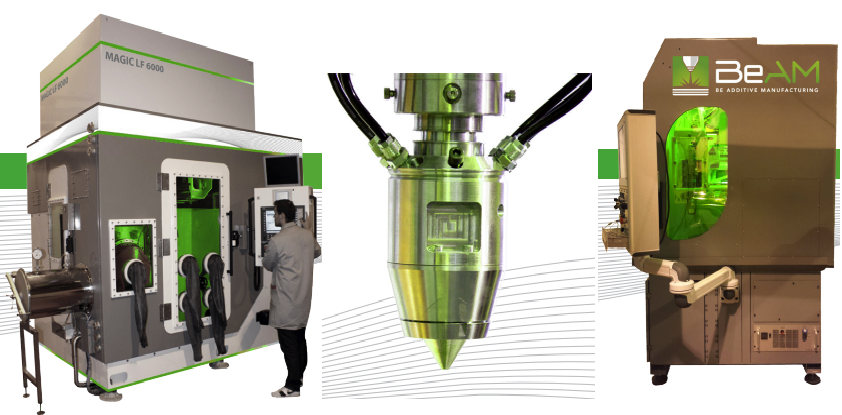 The 3D printing of metal promises to change the face of manufacturing worldwide over the next decade. While the technology is still only very young, the rapid acceleration and innovation within the space will allow companies to streamline the manufacturing of multiple components, greatly increasing design variability, and reducing the space required on the manufacturing floor, as a single machine may be able to replace dozens. Before we get to this point, however, the technology must become more affordable, faster, and perhaps a bit more precise. Further innovations are required within the space and one company based out of Illkirch, France seems to be doing just that.
The 3D printing of metal promises to change the face of manufacturing worldwide over the next decade. While the technology is still only very young, the rapid acceleration and innovation within the space will allow companies to streamline the manufacturing of multiple components, greatly increasing design variability, and reducing the space required on the manufacturing floor, as a single machine may be able to replace dozens. Before we get to this point, however, the technology must become more affordable, faster, and perhaps a bit more precise. Further innovations are required within the space and one company based out of Illkirch, France seems to be doing just that.
BeAM, founded in 2012, is already making strides within the additive manufacturing space, particularly in Europe. They’ve been able to develop a new technique of metal 3D printing which they call CLAD, and not only do they manufacture metal components with this process, but they also are able to repair damaged parts, working with several companies, particularly within the aerospace industry.
You all are likely familiar with the metal 3D printing processes of Direct Metal Laser Sintering (DMLS) and Selective Laser Sintering (SLS), where a bed of metal powder is selectively melted via a high-powered laser beam. BeAM’s CLAD technology works also by melting metal powder, but differs greatly in the fact that no powder bed or sifting of powder is required.
Closely partnered with IREPA LASER, BeAM is able to leverage the advancements inherent within IREPA LASER’s laser technology to create a streamlined additive manufacturing process. BeAM’s 3D printers rely on their important patented CLAD nozzle system which is able to extrude two streams of metal powder at the same instant that a high-powered laser is active. The laser instantaneously melts the extruded metal powder as the nozzle moves along the X and Y axes based on computer input data. An object can then be printed or repaired one layer at a time as you can see from the video below.
Mobile CLAD
- Machine Size: 1200 x 1500 x 2000 mm
- Build Envelope : 400 x 250 x 250 mm
- Configuration of the axes: 3 axes (XYZ)
- Layer Thickness: 0.1 to 0.3 mm/layer
- Powder Size: 45 – 75 µm
CLAD Unit
- Build Envelope: 1000 x 700 x 700 mm
- Configuration of the axes : 3 axes (XYZ) with up to 5 continuous axes (BC)
- Layer Thickness: 0.2 to 0.8 mm/layer
- Power Size: 45 – 90 µm
- Options: One or two nozzles; one or two powder bowls making multiple material deposition possible
MAGIC
- Machine Size: 4.37 x 3.94 x 3.5 m
- Build Envelope: 1500 x 800 x 800 mm
- Configuration of the axes : 3 axes (XYZ) with up to 5 continuous axes (BC)
- Layer Thickness: 0.2 to 0.8 mm/layer
- Powder Size: 45 – 90 µm, 50 – 150 µm
- Options: One or two nozzles; one or two powder bowls making multiple material deposition possible
BeAM is already working with numerous companies, and they have repaired hundreds of parts including aircraft engine turbines. In fact, they’ve partnered with the US-based company Chromalloy to repair numerous types of Pratt & Whitney parts, increasing the operating life of some components from 10,000 to 60,000 hours according to the company. BeAM has also assured us that they are continuing to innovate as they work with a variety of partners to further improve their CLAD technology. For all pricing details, the company asks potential clients to contact them via their website.
BeAM’s approach is certainly an interesting one, both in their method of printing, and their ability to print on already constructed parts for repairs. Let’s hear your thoughts on BeAM’s advanced 3D printing technology, and how 3D printing could find a niche within the metal repairs industry as well. Discuss in the BeAM 3D Printers forum thread on 3DPB.com.
Subscribe to Our Email Newsletter
Stay up-to-date on all the latest news from the 3D printing industry and receive information and offers from third party vendors.
You May Also Like
3D Printing Financials: Fathom Struggles in Financial Quicksand During Critical Transition
Facing a year of key transitions and financial pressures, Fathom (Nasdaq: FTHM) has filed its annual report for 2023 with the U.S. Securities and Exchange Commission (SEC). The document outlines...
Latest Earnings Overview for Australian 3D Printing Firms Titomic and AML3D
Australian 3D printing manufacturing firms Titomic (ASX: TTT) and AML3D (ASX: AL3) reported their financial results for the period from July to December 2023, marking the first half of their...
3D Printing Webinar and Event Roundup: April 7, 2024
Webinars and events in the 3D printing industry are picking back up this week! Sea-Air-Space is coming to Maryland, and SAE International is sponsoring a 3D Systems webinar about 3D...
3D Printing Financials: Unpacking Farsoon and BLT’s 2023 Performance
In the Chinese 3D printing industry, two companies, Farsoon (SHA: 688433) and Bright Laser Technologies, or BLT (SHA: 688333), have recently unveiled their full-year earnings for 2023. Farsoon reported increases...

































